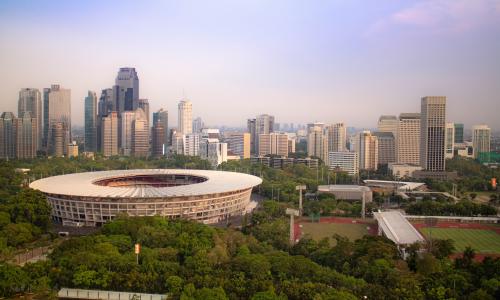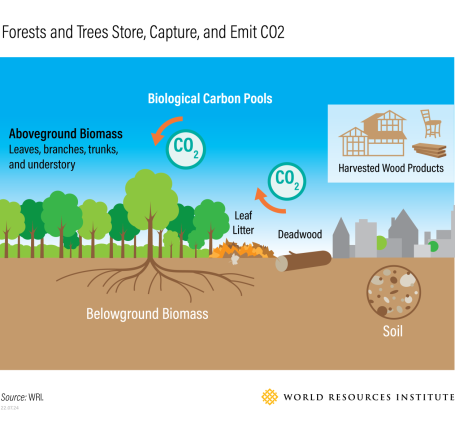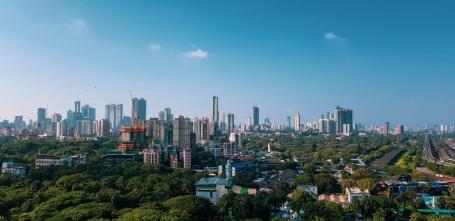
5 Reasons Cities Should Include Trees in Climate Action
Cities and communities around the world are stepping up to cut greenhouse gas (GHG) emissions and prevent dangerous climate change impacts. Their strategies typically focus on reducing emissions from sectors such as transportation, energy, housing and waste. But there’s one sector many communities are overlooking in their climate plans: forests and trees.
This is a major missed opportunity, as trees not only release carbon to the atmosphere when cleared but also remove carbon dioxide from the atmosphere as they grow, as well as provide a myriad of other benefits for cities and other communities.
Why Are Communities Leaving Trees Out of Climate Action?
GHG inventories are an important first step in designing a climate action strategy, as they pinpoint where a community’s emissions come from and where the biggest reduction opportunities lie. However, until now, cities and communities have lacked detailed guidance on how to inventory GHG emissions from forests and trees within their borders.
New guidance developed by WRI, ICLEI – Local Governments for Sustainability and C40 Cities aims to change that. The new supplemental guidance for forests and trees to the Global Protocol for Community-Scale Greenhouse Gas Inventories (GPC) — piloted in Jakarta, Mexico City, Mumbai, Salvador and multiple U.S. communities — walks cities and other communities through the process of estimating annual emissions and removals by forests and trees in their jurisdictions, including urban trees and trees in agricultural landscapes.
While the mitigation potential of urban trees and forests may be small compared to other sectors, other less urbanized communities around the world may have substantial forest and tree cover as well as significant opportunities for more. Across the board, there are several reasons why they can and should be part of communities’ efforts to reduce emissions. Here are five reasons communities should include trees and forests in both their GHG inventories and climate change mitigation and adaptation plans:
1. Trees and forests both emit and remove carbon.
When forests and trees are cleared or degraded — such as from urban development, from agriculture or by fires — they become a source of carbon to the atmosphere. Globally, about 10% of all carbon dioxide emissions added to the atmosphere each year are from land use change and forestry. Trees release carbon into the atmosphere as they break down, and land’s ability to remove excess carbon from the atmosphere is reduced without those trees.
Conversely, when forests and trees are left standing, protected, restored and planted, they sequester carbon as they grow, thereby removing CO2 from the atmosphere and mitigating climate change.

Because of the lack of detailed guidance until now, most cities and communities have not tried to estimate how much the loss and degradation of forests and trees in their boundaries is already contributing to their carbon emissions, or how remaining trees may be helping to sequester carbon. Cities and communities need to acknowledge these dual roles and strive to preserve and enhance their “carbon sink.”
Take the example of Montgomery County, Maryland, a heavily forested county on the U.S. East Coast. It has many parks with mature forests, forested areas that protect important watersheds, and plentiful suburban and agricultural landscapes that include trees. As a result, the forests of Montgomery County act as a net carbon sink, as a whole sequestering more carbon than they emit when felled for development. The county is using data generated from its GHG inventory for forests and trees to better understand its land management practices, such as reducing tree removal during development, accounting for lost carbon sequestration potential when trees are removed, and planning tree-planting programs.
2. Protecting urban forests is low-hanging fruit, even if mitigation potential is small.
In urban settings, forests and trees may make up a relatively small piece of the overall climate puzzle, often because they are dwarfed by the immense emissions from other sectors like transportation and energy. This is especially true for large cities, such as many of the ones where this guidance was piloted.
However, these emissions are still important to factor into the city’s climate action plan because they represent relatively low-hanging fruit for cutting emissions and maintaining removals while changes in other higher-emitting sectors are being instituted. Conserving forests and avoiding forest degradation is renowned as one of the most cost-effective strategies to lower emissions. Many communities are pledging to achieve carbon neutrality by mid-century, and forests and trees can help achieve the last mile of emission reductions needed to achieve these ambitious climate goals. At the global scale, ending forest conversion, preserving existing forest carbon sinks and restoring degraded forests has the potential to avoid more than one-third of emissions.
3. Urban trees and forests are important for climate adaptation.
Trees can provide significant benefits for adaptation by providing buffers to certain climate risks and making urban spaces more livable.
For example, in highly urbanized Jakarta — a city which has minimal forest and suffers perennially with the impacts of climate change — the loss of urban trees is a small carbon source, and protection of Jakarta’s existing millions of trees is a small carbon sink relative to other sectors’ emissions. Yet the city’s urban trees provide tremendous benefits for making the city more resilient. Urban trees help protect life and property from the impacts of stormwater by promoting infiltration into the ground and reducing the volume and speed of surface water runoff. They reduce the frequency and intensity of flood events by storing water in the surrounding soil — especially upstream — and preventing erosion. And they can even clean the air that Jakarta’s 11 million residents breathe by collecting airborne particulate matter on their leaves and removing some harmful gases.
In other cities, trees can lower temperatures by providing shade and through evapotranspiration, thereby reducing heat island effect and cooling cities during dangerous and more frequent heat waves. They can also improve local food and nutrition security by providing food such as fruit, nuts and leaves for human and livestock consumption.
4. Expanding tree cover can address inequities.
Once cities understand how much carbon their forests and trees are emitting and removing from the atmosphere, they may take a more keen interest in expanding tree cover across their boundary to further make use of this powerful natural climate solution. This represents a timely opportunity for them to address inequitable access to trees and green space, a phenomenon all-too-common in big cities around the world. Wealthier suburbs typically have more trees than poorer areas, leaving low-income residents more likely to experience hotter neighborhoods and higher levels of air pollution and stormwater flooding.
For example, the city of Mumbai is comprised of 27 wards. There is a vast difference in tree canopy cover between wealthy wards like Borivali with 35% tree cover, and less wealthy wards like Dadar, where tree cover is estimated at only 8%. This new understanding of how the city’s trees contribute to its mitigation efforts enables the city to plan for equitable increases in tree cover across the wards, as laid out in its recently published climate action plan.

5. The benefits of forests and trees go well beyond climate.
Urban trees provide many benefits beyond climate mitigation and adaptation, including improving residents’ health and well-being by decreasing high blood pressure, reducing stress and improving mood, boosting immune systems, reducing the risk of some psychological disorders, and supporting mental development in children. Access to greenery through “forest bathing” or “nature walks” is increasingly linked to physical and mental health benefits. Some doctors are even prescribing these activities to treat conditions such as anxiety and depression.
Urban trees and forests also provide habitat for biodiversity and can support human livelihoods through the creation of jobs to maintain and manage trees and green spaces.
Helping Cities and Communities Use Trees and Forests to Take a Larger Role in Climate Action
Of course, even cities and communities with large amounts of forests should not rely on them alone to reduce emissions. As places that will house 80% of the world’s population by 2050, the war against climate change will be fought on the city battlefield. Cities should rein in emissions from every sector — transportation, energy, industry and more. Forests and trees must be part of the strategy.
Introducing the GPC Supplemental Guidance for Forests and Trees
With the launch of this supplemental guidance, cities and communities around the world can estimate the climate impact and benefits of their forests and trees, and potentially include them in their climate action plans. Programs like Cities4Forests, CitiesWithNature and C40's Climate Action Planning Framework are supporting hundreds of cities and communities around the world to do so. The new guidance follows the IPCC GHG inventory methods, which means that city and community forest and tree GHG inventories can also be more aligned with national GHG inventories. This can help national governments account for city-led efforts in their mitigation strategies. For a more detailed overview of the guidance, please see this post on TheCityFix.